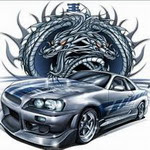

The Honda Pilot is among an elite group of sport utility vehicles that helped elevate the "crossover" segment in the last decade by introducing a combination of smooth ride comfort, accommodating interior packaging and overall efficiency that traditional SUVs lacked. The Pilot's unit body construction and fully independent suspension helped transform the SUV segment by enhancing ride quality, earning top crash safety ratings, creating more interior space and increasing fuel efficiency. The original Pilot provided a recipe for success with features eventually imitated by the competition like a standard third row seat, decision-free four-wheel drive and an easy-to-configure interior.
The second generation of the Honda Pilot seeks to improve on the popular Honda SUV formula by adding more SUV-rugged aesthetics, more on-road refinement and enhancing interior functionality. Designed around the concept of an "intelligent adventure vehicle" with the practical needs of a family in mind, the eight-passenger Pilot provides bolder SUV styling, more clever and more accommodating interior packaging and advanced technologies for safety, fuel efficiency and convenience.
Powertrain
The Honda Pilot is designed to provide a comfortable, confident and fun driving experience with plenty of power to match its capabilities as an eight-passenger SUV with off-road capabilities and up to 4,500-pound towing capabilities (4WD). For 2009, Honda engineers prioritized fuel efficiency for the all-new Pilot and applied the latest generation of the company's Variable Cylinder Management technology to all models. Low emissions, a broad torque curve and low maintenance were also key development targets.
The Honda Pilot is powered by an advanced 3.5-liter 24-valve i-VTEC, V-6 engine mated to an electronically-controlled 5-speed automatic transmission. Peak engine output is 250 horsepower at 5700 rpm and 253 lb-ft. of torque at 4800 rpm. The "intelligent" Variable Valve Timing and Lift Electronic Control (i-VTEC®) valvetrain technology with Variable Cylinder Management (VCM) allows the V-6 engine to operate in six-cylinder mode for power and four- and three-cylinder modes for efficiency. The Pilot meets California's stringent Ultra Low Emissions Vehicle (ULEV-2) exhaust emissions standards. A fully-automatic Variable Torque Management 4-wheel drive system (VTM-4) is available on all models and delivers seamless "decision free" application of four-wheel drive when needed.
Safety
Honda has consistently challenged itself to pursue vehicle safety as part of its core business strategy. The company seeks to provide a high level of occupant protection and pedestrian injury mitigation in all of its cars and trucks through a comprehensive and evolving approach to vehicle safety. This process benefits all new Honda vehicles - regardless of size or price - while also increasing compatibility with other types of vehicles in a frontal collision.
The 2009 Honda Pilot exemplifies the Honda approach to safety. Every Honda Pilot incorporates side-curtain airbags and dual-chamber, front-side airbags with a passenger-side Occupant Position Detection System (OPDS); and active front seat head restraints that are designed to help reduce the severity of neck injury in the event of a rear collision.
An Advanced Compatibility Engineering™ (ACE®) body structure in the front of the vehicle, now added to Honda Pilot for the first time, makes the new Pilot highly effective at absorbing the energy of a frontal crash and helps minimize the potential for under-ride or over-ride situations that can occur during head-on or offset-frontal impacts with a significantly larger or smaller vehicle. Vehicle Stability Assist™ (VSA®) and an Anti-lock Brake System (ABS) with brake assist are standard equipment on every Honda Pilot.
Additional standard safety features include dual-stage, dual-threshold front airbags, front seatbelts with automatic-tensioning systems and load limiters, and a pedestrian injury mitigation design in the front of the vehicle. Driver and front passenger seatbelt reminders and daytime running lights are also standard equipment. A class-leading total of four Lower Anchors and Tethers for Children (LATCH) positions provide rigid attachment points for up to four child seats.




No comments:
Post a Comment